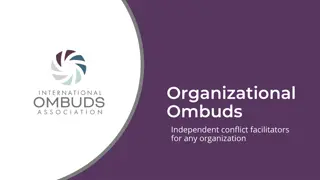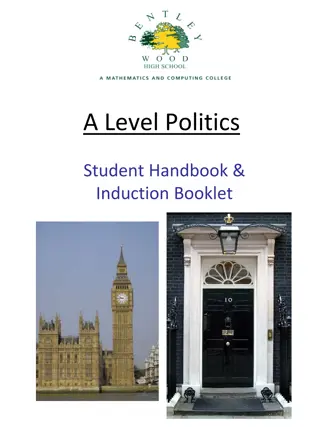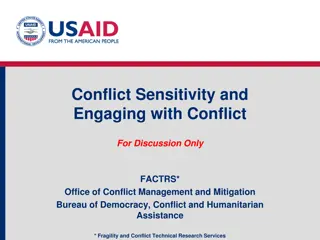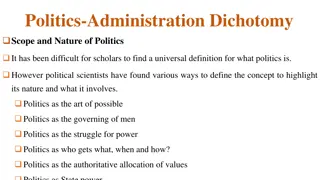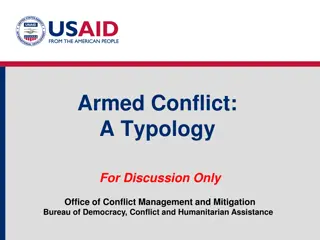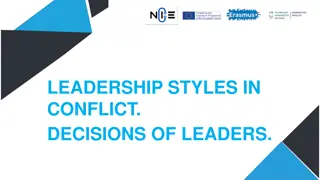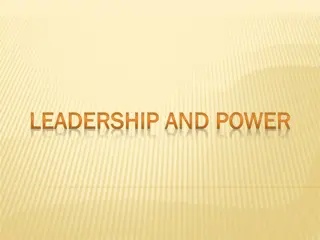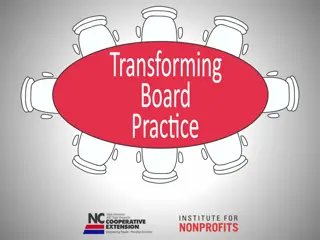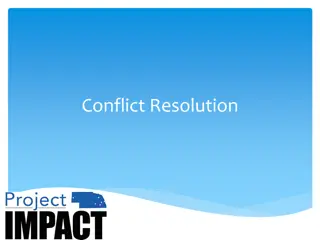Understanding Power, Politics, and Conflict Management in Organizations
Explore the dynamics of power, authority, leadership, and politics within organizations, delving into how individuals and groups influence each other's actions and decisions. Learn about the various bases of power, common power tactics, and ethical considerations in using power and politics in the workplace. Additionally, gain insights into recognizing and addressing issues like bullying, harassment, and violence in organizational settings.
Download Presentation

Please find below an Image/Link to download the presentation.
The content on the website is provided AS IS for your information and personal use only. It may not be sold, licensed, or shared on other websites without obtaining consent from the author. Download presentation by click this link. If you encounter any issues during the download, it is possible that the publisher has removed the file from their server.
E N D
Presentation Transcript
CONFLICT MANAGEMENT CHAPTER 4: POWER AND POLITICS Unless otherwise noted, this work is licensed under a Creative Commons Attribution-NonCommercial-ShareAlike 4.0 International (CC BY-NC-SA 4.0) license. Feel free to use, modify, reuse or redistribute any portion of this presentation.
Learning Outcomes Upon successful completion of this chapter, you will be able to: Define power. Contrast power, leadership, and authority. Recognize symbols of managerial power. Explain the relationship between power and dependency. Review the bases of power. Compare the different use of power bases and the likelihood that they will result in resistance, compliance, or commitment. Summarize common power tactics used in the workplace. Define politics. Identify individual and organizational antecedents of political behaviour, Recognize common influence tactics and their outcomes. Describe potential directions of influence. Explore suggestions for how-to use power and politics ethically in the workplace. Define bullying, harassment, and violence. Recognize that bullying and harassment disproportionally impact some groups more than others. Review types of bullying. Compare response to bullying and harassment. Identify the role or organizations in reducing and addressing bullying and harassment
4.1 Power I Power can be defined as an interpersonal relationship in which one individual (or group) has the ability to cause another individual (or group) to take an action that would not be taken otherwise.
4.1 Power II The concept of power is closely related to the concepts of authority and leadership
4.1 Power III Symbols of Managerial Power How do we know when a manager has power in an organizational setting? Harvard professor Rosabeth Moss Kanter (2004) has identified several of the more common symbols of managerial power. Image by Tumisu from Pixabay
4.1 Power IV Relationship Between Dependency & Power
4.1 Power V Bases of Power Having power and using power are two different things. What are the sources of one s power over others? Researchers identified six sources of power, which include legitimate, reward, coercive, expert, information, and referent. (French & Raven, 1960).
For our purposes here, we will adopt Pfeffer s (2011) definition of politics as involving those activities taken within organizations to acquire, develop, and use power and other resources to obtain one s preferred outcomes in a situation in which there is uncertainty or dissensus about choices (p. 8). 4.2 Politics and Influence I Organizational politics are informal, unofficial, and sometimes behind-the-scenes efforts to sell ideas, influence an organization, increase power, or achieve other targeted objectives (Brandon & Seldman, 2004: Hochwarter et al., 2000).
4.2 Politics and Influence II Reasons for Political Behaviour
4.2 Politics and Influence III Commonly Used Influence Tactics Researchers have identified distinct influence tactics and discovered that there are few differences between the way managers, subordinates, and peers use them. Rational Persuasion Inspirational Appeals Consultation Ingratiation Personal Appeals Exchange Coalition Tactics Pressure Legitimating
4.2 Politics and Influence IV Direction of Influence The type of influence tactic used tends to vary based on the target. For example, you would probably use different influence tactics with your boss, with employees working under you, or with a peer.
4.2 Politics and Influence V Upward Influence Upward influence, as its name implies, is the ability to influence your manager and others in positions higher than yours. Upward influence may include appealing to a higher authority or citing the firm s goals as an overarching reason for others to follow your cause. Image by Wilson Joseph from Pixabay
4.2 Politics and Influence VI Downward Influence Downward influence is the ability to influence employees lower than you in the institutional hierarchy. This is best achieved through an inspiring vision. By articulating a clear vision, you help people see the end goal and move toward it. Image by Wilson Joseph from Pixabay
4.3 Ethical Use of Power and Politics I The Ethical Use of Power People are often uncomfortable discussing the topic of power, which implies that somehow they see the exercise of power as unseemly. On the contrary, the question is not whether power tactics are or are not ethical; rather, the question is which tactics are appropriate and which are not.
4.3 Ethical Use of Power and Politics II Several guidelines for the ethical use of power can be identified. Referent power Expert power Legitimate power Reward power Coercive power
4.3 Ethical Use of Power and Politics III The Ethical Use of Politics Similar to power, there is not inherent good or bad in politics. Politics in organizations cannot be eliminated. Yet to some extent, the negative aspects of it can be neutralized if managers carefully monitor the work environment and take remedial action where necessary.
4.3 Ethical Use of Power and Politics IV Several strategies can be identified that can help manage organizational politics. Four basic strategies that can be used are: Reduce System Uncertainty Reduce Competition Break Existing Political Empires/Coalitions Prevent Future Political Empires/Coalitions
4.4 Bullying, Violence, and Harassment I Harassment, bullying, and violence are examples of psychosocial hazards that negatively affect worker health and safety. These behaviours are unacceptable and illegal, but nonetheless, still occur. These abuses are often grounded in misuse of power and are often visible during dysfunctional and escalating conflicts.
4.4 Bullying, Violence, and Harassment II Workplace harassment is behaviour aimed at an individual (or group) that is belittling or threatening in nature. Image by mohamed Hassan from Pixabay
4.4 Bullying, Violence, and Harassment III Bullying is similar to harassment and comprises repeated actions or verbal comments that lead to mental harm, isolation, or humiliation of a worker (or group), often with the intent to wield power over them. Image by Gerd Altmann from Pixabay
4.4 Bullying, Violence, and Harassment IV Types of Bullying Behaviours Isolation and exclusion Intimidation and threats Verbal threats Damaging professional identity Limiting career opportunities Obstructing work or making work-life difficult Denial of due process and natural justice
4.4 Bullying, Violence, and Harassment V Responses to Bullying and Harassment Workers respond to threats such as bullying with a range of behaviours that include: Exit Voice Patience Neglect.
4.5 Key Takeaways Power is the ability to influence the behavior of others to get what you want. Power is distinct from both leadership and authority. Symbols of managerial power include access to key people and resources within an organization. Power is closely tied to dependency. There are many bases of power Depending upon which kind of power is employed, the recipient of a power effort can respond with commitment, compliance, or resistance. Common power tactics include controlling access to information, controlling access to persons, the selective use of objective criteria, controlling the agenda and using outside experts. Organizational politics is a natural part of organizational life. Individual antecedents of political behavior include political skill, internal locus of control, high investment in the organization, and expectations of success. Organizational antecedents include scarcity of resources, role ambiguity, frequent performance evaluations and promotions, and democratic decision making. Political behavior is more likely to occur when there are scarce resources, ambiguity, performance evaluations/promotions, and democratic and/or nonprogrammed decisions. Influence tactics are the way that individuals attempt to influence one another in organizations. Influence attempts may be upward, downward, or lateral in nature. Workplace harassment is behaviour aimed at an individual (or group) that is belittling or threatening in nature. Bullying is similar to harassment and comprises repeated actions or verbal comments that lead to mental harm, isolation, or humiliation of a worker (or group), often with the intent to wield power over them.












